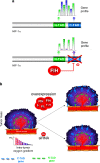A dialogue between the hypoxia-inducible factor and the tumor microenvironment
- PMID: 19308685
- PMCID: PMC2654353
- DOI: 10.1007/s12307-008-0006-3
A dialogue between the hypoxia-inducible factor and the tumor microenvironment
Abstract
The hypoxia-inducible factor is the key protein responsible for the cellular adaptation to low oxygen tension. This transcription factor becomes activated as a result of a drop in the partial pressure of oxygen, to hypoxic levels below 5% oxygen, and targets a panel of genes involved in maintenance of oxygen homeostasis. Hypoxia is a common characteristic of the microenvironment of solid tumors and, through activation of the hypoxia-inducible factor, is at the center of the growth dynamics of tumor cells. Not only does the microenvironment impact on the hypoxia-inducible factor but this factor impacts on microenvironmental features, such as pH, nutrient availability, metabolism and the extracellular matrix. In this review we discuss the influence the tumor environment has on the hypoxia-inducible factor and outline the role of this factor as a modulator of the microenvironment and as a powerful actor in tumor remodeling. From a fundamental research point of view the hypoxia-inducible factor is at the center of a signaling pathway that must be deciphered to fully understand the dynamics of the tumor microenvironment. From a translational and pharmacological research point of view the hypoxia-inducible factor and its induced downstream gene products may provide information on patient prognosis and offer promising targets that open perspectives for novel "anti-microenvironment" directed therapies.
Figures


 , stimulation;
, stimulation;  , inhibition;
, inhibition;  , interaction
, interaction





Similar articles
-
Cell metabolism under microenvironmental low oxygen tension levels in stemness, proliferation and pluripotency.Curr Mol Med. 2015;15(4):343-59. doi: 10.2174/1566524015666150505160406. Curr Mol Med. 2015. PMID: 25941818
-
Perspectives on Hypoxia Signaling in Tumor Stroma.Cancers (Basel). 2021 Jun 20;13(12):3070. doi: 10.3390/cancers13123070. Cancers (Basel). 2021. PMID: 34202979 Free PMC article. Review.
-
Hypoxia inducible factor (HIF) in the tumor microenvironment: friend or foe?Sci China Life Sci. 2017 Oct;60(10):1114-1124. doi: 10.1007/s11427-017-9178-y. Epub 2017 Oct 13. Sci China Life Sci. 2017. PMID: 29039125 Free PMC article. Review.
-
The oxygen sensor factor-inhibiting hypoxia-inducible factor-1 controls expression of distinct genes through the bifunctional transcriptional character of hypoxia-inducible factor-1alpha.Cancer Res. 2006 Apr 1;66(7):3688-98. doi: 10.1158/0008-5472.CAN-05-4564. Cancer Res. 2006. PMID: 16585195
-
From tumor hypoxia to cancer progression: the implications of hypoxia-inducible factor-1 expression in cancers.Anat Cell Biol. 2012 Jun;45(2):73-8. doi: 10.5115/acb.2012.45.2.73. Epub 2012 Jun 30. Anat Cell Biol. 2012. PMID: 22822460 Free PMC article.
Cited by
-
Broussonin E against acute respiratory distress syndrome: the potential roles of anti-inflammatory.Naunyn Schmiedebergs Arch Pharmacol. 2024 May;397(5):3195-3209. doi: 10.1007/s00210-023-02801-1. Epub 2023 Oct 31. Naunyn Schmiedebergs Arch Pharmacol. 2024. PMID: 37906275
-
Hypoxia-Inducible Factor Regulates Endothelial Metabolism in Cardiovascular Disease.Front Physiol. 2021 Jul 5;12:670653. doi: 10.3389/fphys.2021.670653. eCollection 2021. Front Physiol. 2021. PMID: 34290616 Free PMC article. Review.
-
Targeting Endothelial HIF2α/ARNT Expression for Ischemic Heart Disease Therapy.Biology (Basel). 2023 Jul 13;12(7):995. doi: 10.3390/biology12070995. Biology (Basel). 2023. PMID: 37508425 Free PMC article. Review.
-
Tumour-associated mesenchymal stem/stromal cells: emerging therapeutic targets.Nat Rev Drug Discov. 2017 Jan;16(1):35-52. doi: 10.1038/nrd.2016.193. Epub 2016 Nov 4. Nat Rev Drug Discov. 2017. PMID: 27811929 Review.
-
Antitumor Therapy Targeting the Tumor Microenvironment.J Oncol. 2023 Mar 3;2023:6886135. doi: 10.1155/2023/6886135. eCollection 2023. J Oncol. 2023. PMID: 36908706 Free PMC article. Review.
References
-
- {'text': '', 'ref_index': 1, 'ids': [{'type': 'PubMed', 'value': '11181773', 'is_inner': True, 'url': 'https://pubmed.ncbi.nlm.nih.gov/11181773/'}]}
- Hockel M, Vaupel P (2001) Tumor hypoxia: definitions and current clinical, biologic, and molecular aspects. J Natl Cancer Inst 93:266–276 - PubMed
-
- {'text': '', 'ref_index': 1, 'ids': [{'type': 'PMC', 'value': 'PMC1820761', 'is_inner': False, 'url': 'https://pmc.ncbi.nlm.nih.gov/articles/PMC1820761/'}, {'type': 'PubMed', 'value': '17043737', 'is_inner': True, 'url': 'https://pubmed.ncbi.nlm.nih.gov/17043737/'}]}
- Padhani AR, Krohn KA, Lewis JS et al (2007) Imaging oxygenation of human tumours. Eur Radiol 17:861–872 - PMC - PubMed
-
- {'text': '', 'ref_index': 1, 'ids': [{'type': 'PubMed', 'value': '10919633', 'is_inner': True, 'url': 'https://pubmed.ncbi.nlm.nih.gov/10919633/'}]}
- Baish JW, Jain RK (2000) Fractals and cancer. Cancer Res 60:3683–3688 - PubMed
-
- {'text': '', 'ref_index': 1, 'ids': [{'type': 'PMC', 'value': 'PMC549205', 'is_inner': False, 'url': 'https://pmc.ncbi.nlm.nih.gov/articles/PMC549205/'}, {'type': 'PubMed', 'value': '15701176', 'is_inner': True, 'url': 'https://pubmed.ncbi.nlm.nih.gov/15701176/'}]}
- Grizzi F, Russo C, Colombo P et al (2005) Quantitative evaluation and modeling of two-dimensional neovascular network complexity: the surface fractal dimension. BMC Cancer 5:14 - PMC - PubMed
-
- {'text': '', 'ref_index': 1, 'ids': [{'type': 'PubMed', 'value': '13130303', 'is_inner': True, 'url': 'https://pubmed.ncbi.nlm.nih.gov/13130303/'}]}
- Semenza GL (2003) Targeting HIF-1 for cancer therapy. Nat Rev Cancer 3:721–732 - PubMed
LinkOut - more resources
Full Text Sources
